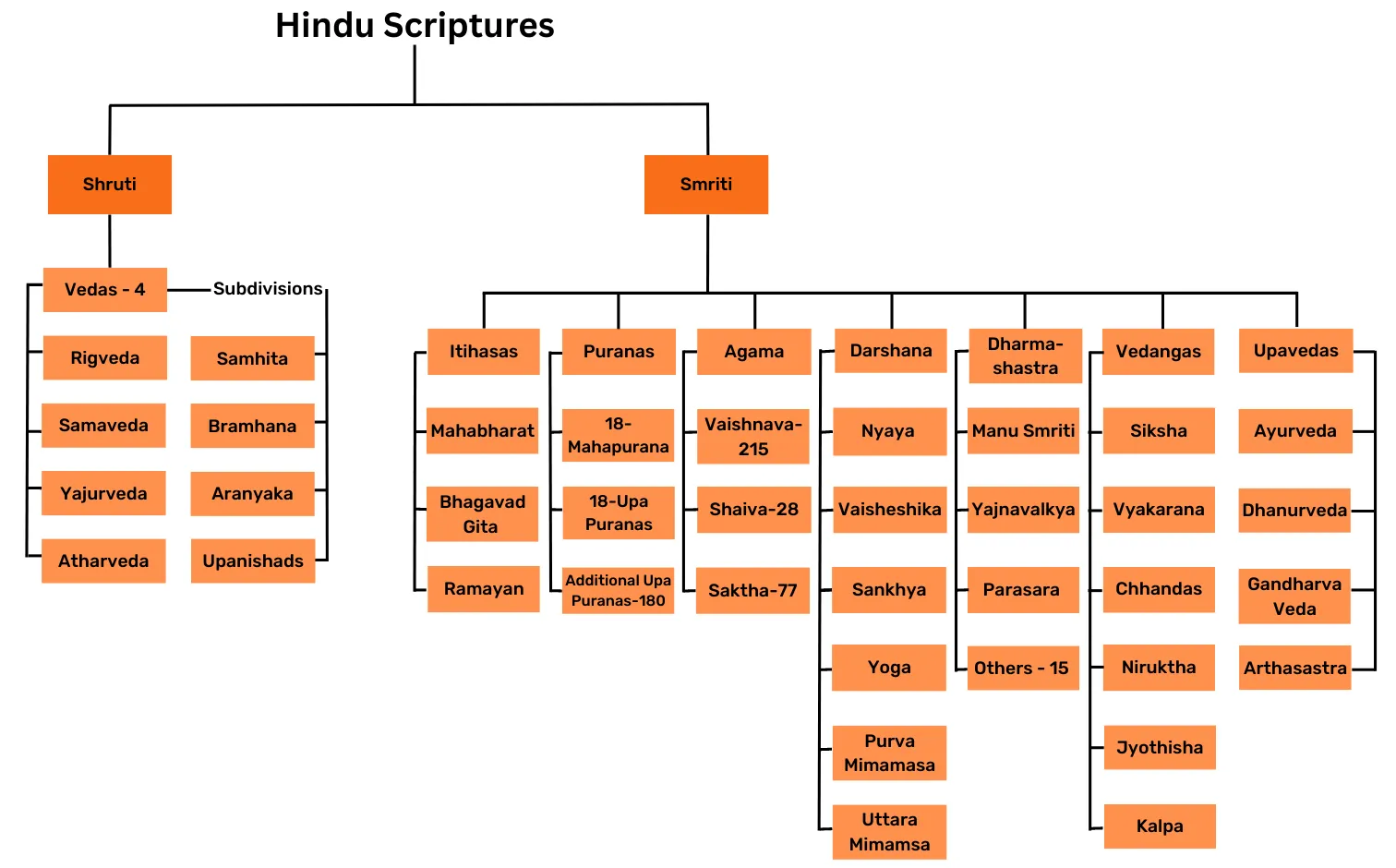Explore the topics on the “Classification of Vedic literature” to better understand the numerous divisions, classifications, and types of diverse Vedic literature, which is the earliest source of Hindu religious texts.
Classification of Vedic Literature Based on Time Period
Early Vedic Literature
- Also known as Rig Vedic Culture
- Time-period: (c. 1500–1000 BCE)
- Includes Rig Veda Samhita and other family texts
- Termed as ‘family books’ with compositions attributed to visionary poets like Vishvamitra, Atri, Gritsamada, Vasishtha, and Bharadvaja
Later Vedic Literature
- Also known as Later Vedic Culture
- Time Period (c. 1000–500 BCE)
- Includes Books 1, 8, 9, and 10 of Rig Veda Samhita
- Encompasses Samhitas of Sama Veda, Yajur Veda, and Atharva Veda
- Comprises Brahmanas, Aranyakas, and Upanishads attached to all four Vedas
About Veda
Derivation of the Word “Veda”
- Veda originates from the root ‘vid,’ meaning to know/knowledge.
Nature of Vedas
- Hold the status of Shruti (which has been heard)
- Initially transmitted orally for many centuries
- Later written down, with the earliest surviving manuscript dating back to the 11th century
Structure of Vedas
Each Veda generally consists of four parts:
- Samhita
- Brahmana
- Aranyaka
- Upanishad

Classification of Vedic Literature based on the method of Teaching
Vedic literature is a vast and diverse collection of ancient Indian texts, considered the foundation of Hinduism and a vital source of knowledge about ancient Indian history, culture, and philosophy. It can be broadly classified into two main categories:
Vedic Shruti Literature
- Meaning “that which is heard” in Sanskrit, Shruti refers to the revealed or eternal texts considered of divine origin and passed down orally from generation to generation before being compiled in written form.
- Shruti is considered the highest source of authority in Hinduism.
Shruti includes the following subcategories:
- The Four Vedas: These are the oldest and most revered texts of Hinduism, consisting of hymns, prayers, and rituals.
- Brahmanas: These texts explain the rituals mentioned in the Vedas and provide detailed commentary on their meaning and significance.
- Aranyakas: These texts are meant for those who have retired to the forest and focus on philosophical and mystical aspects of the Vedas.
- Upanishads: Considered the pinnacle of Vedic literature, these texts deal with philosophical questions about the nature of reality, the self, and the ultimate goal of human existence.
- Samhitas: These are the mantra texts of the four Vedas – Rigveda, Samaveda, Yajurveda, and Atharvaveda.
Vedic Smriti Literature
- Meaning “that which is remembered” in Sanskrit, Smriti refers to texts composed by humans and passed down through oral tradition.
- Smriti is considered secondary to Shruti but still holds a significant place in Hinduism.
Some of the important Smriti texts include:
- Epics/Itihasas: The two great epics of Hinduism, are the Ramayana and the Mahabharata.
- Puranas: A collection of mythological stories and legends that explain the universe’s origins, the lives of gods and goddesses, and the history of kings and dynasties.
- Dharmashastras: These texts deal with law, morality, and social customs.
- Sutras: These are concise and aphoristic texts that cover various aspects of Hindu knowledge, such as law, medicine, and astronomy.
- Vedangas: The Vedangas are often referred to as the components of the Veda, and their recognition is traced back to the Mundaka Upanishad.
- Upveda: The Upavedas are subsidiary texts associated with the four Vedas. They delve into specific applications of Vedic teachings within various cultural domains.
- Agama: Agamas are a group of scriptures in Hinduism, particularly associated with temple rituals, worship, and deity worship.
- Darshana: Darshana refers to philosophical systems or schools of thought in Indian philosophy. Each Darshana offers a unique metaphysics, epistemology, ethics, and cosmology perspective.
✅ Major Source: Poonam Dalal Dahiya Ancient History, Testbook
✅ Explore All Indian History Notes: Gkbooks History Notes
Explore More Indian History Notes:
Important Books and Their Authors During the Freedom Struggle
Literature of Gupta Period – Epics, Puranas, Famous Authors & Other Types of Literature
Bindusara: All about the Second Mauryan Emperor (320 BCE – 273 BCE)
Indian National Congress Sessions List with Additional Key Facts
Introduction of The Harappan Civilization: 3 Phases with Key Details
Prehistoric Phase Classification with Key Points: Ancient Indian History

